The Economics and Statistics Division maintains archives of previous publications for accountability purposes, but makes no updates to keep these documents current with the latest data revisions from Statistics Canada. As a result, information in older documents may not be accurate. Please exercise caution when referring to older documents. For the latest information and historical data, please contact the individual listed to the right.
<--- Return to Archive
For additional information relating to this article, please contact:
February 26, 2021CAPITAL AND REPAIR EXPENDITURES SURVEY, 2020 (PRELIMINARY) AND 2021 (INTENTIONS) Statistics Canada has released preliminary estimates for 2020 and intentions for 2021 from the annual survey of capital expenditures for non-residential construction and machinery and equipment. The Capital and Repair Expenditures Survey is based on a sample survey of 25,000 private and public organizations. The survey on intentions for 2021 was conducted from September 2020 to January 2021.
The COVID-19 pandemic has slowed economic activity and altered capital plans for Canadian companies. Preliminary estimates on Nova Scotia's capital expenditures for 2020 were revised up to $4,333.8 million, a gain of 2.0% (+$83.7 million) compared to 2019.
Capital expenditures include both new capital construction and machinery and equipment spending. Capital construction in 2020 for Nova Scotia increased 18.8% to $2,756.3 million. Private construction fell 11.7% while public construction increased 44.4% over 2019. Machinery and equipment was down 18.2% to $1,577.6 million in 2020, with declines in private investment (-22.4%, -364.2 million) slightly offset by a rise in public investment (+4.1%, +$12.2 million).
Capital expenditure intentions for 2021 are for a decrease of 1.8% (-$77.9 million) to $4,255.9 million. Compared to 2020, private construction (-1.4%, +$12.7 million) is expected to lower while private machinery and equipment spending (+7.5%, +$94.2 million) is expected to rise. Above average public capital construction is expected to continue through 2021 with capital construction lowering 4.7% (-84.8 million) from 2020. Intentions for public machinery and equipment spending in 2021 (-23.9%, -$74.7 million) are closer to historical levels after higher expenditures in the past three years.
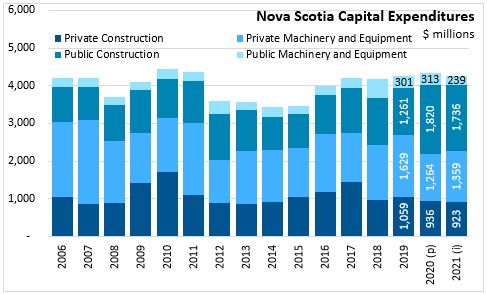
Repair expenditures increased 7.8% in 2019, down from a 9.1% gain in 2018. Repair expenditures increased for structures (+5.5%) and machinery and equipment (+10.2%). Repair expenditures increased more in the private sector (+10.4%) than for the public sector (+2.5%) in 2019.
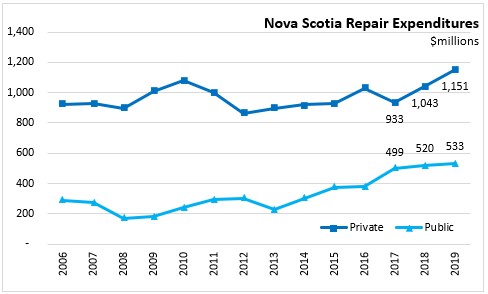
On an industry basis for Nova Scotia, the $84 million decrease in capital expenditures for 2020 was due largely to declines in:
agriculture, forestry, fishing and hunting (-$19 million)
construction (-$11 million)
manufacturing (-$54 million)
retail trade (-$27 million)
transportation/warehousing (-$78 million)
information/cultural (-$11 million)
real estate/rental (-$174 million)
arts, entertainment and recreation (-$14 million)
accommodation and food services (-$47 million)
while notable increases in capital expenditures occurred for:
utilities (+$16 million)
education services (+$179 million),
health care (+$102 million)
public administration (+$267 million).
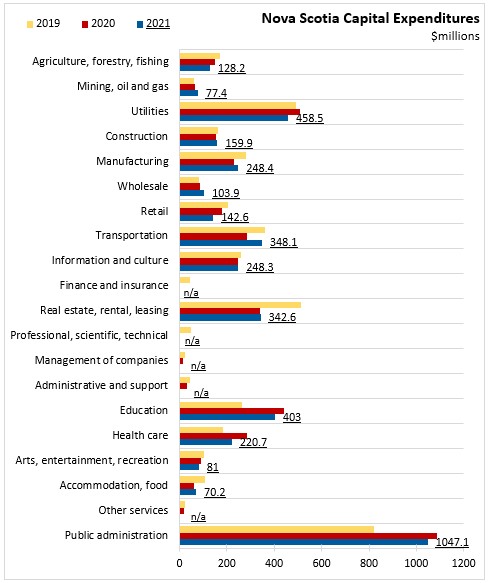
For 2021, total capital expenditures are expected to decrease by 1.8 per cent or $78 million for Nova Scotia, with increases for:
mining, quarrying and oil and gas extraction (+$12 million)
manufacturing (+$20 million)
wholesale trade (+19 million)
transportation/warehousing (+$64 million).
and decreases in capital expenditures for:
agriculture, forestry, fishing and hunting (-$22 million)
utilities (-$50 million)
retail trade (-$36 million)
education services (-$39 million),
health care (-$66 million)
public administration (-$40 million).
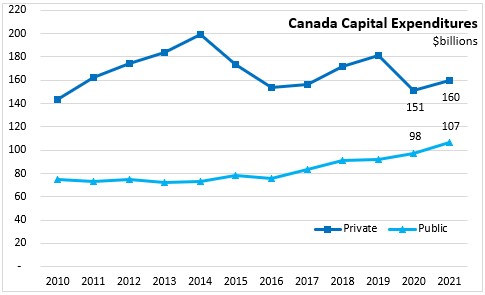
Canada is expected to see an increase of 7.0% in capital expenditures in 2021 following a decrease of 9.2% in 2020 due largely to the COVID-19 pandemic shock. Growth in capital expenditures is led by the transportation and warehousing sector in 2020 and 2021, given its important logistical role in the economy. Capital spending in the mining, quarrying, and oil and gas extraction sector is expected to rise in 2021 following a substantial decline in 2020. Reduced spending for the accommodation and food services sector in 2020 is expected to extend through 2021 due to government public health restrictions related to COVID-19. Elevated investment from the public sector is expected to continue in 2021, while investment by private sector organizations, which decreased in 2020, is expected to have a modest recovery in 2021.
Prince Edward Island (+9.4%), British Columbia (+2.4%) and Nova Scotia (+2.0%) were the only provinces to record growth in capital spending in 2020. For 2021, increased investment in non-residential construction and machinery and equipment is expected in 7 of 10 provinces. Investment spending is expected to increase in Ontario (+9.1% to $83.9 billion) and Quebec (+10.9% to $48.3 billion) following decreases in 2020, as both provinces were more affected by COVID-19 than other jurisdictions. All Atlantic provinces except New Brunswick anticipate reduced capital investment in 2021.
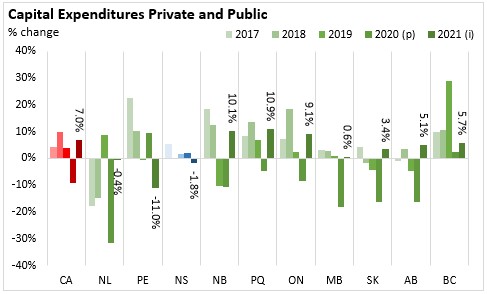
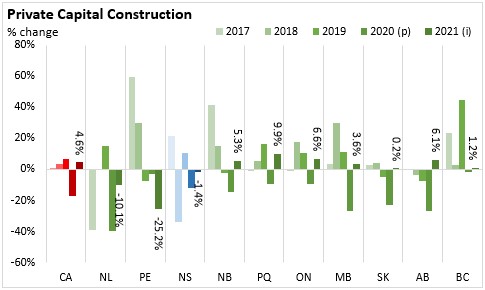
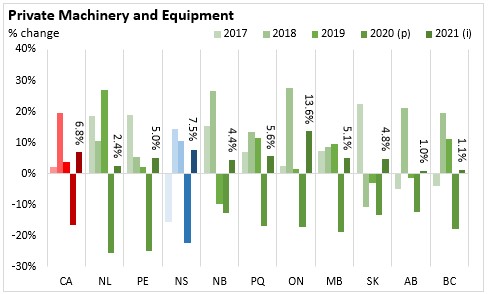
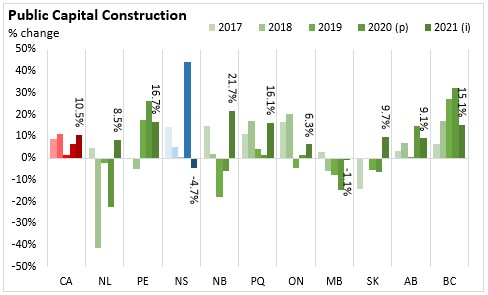
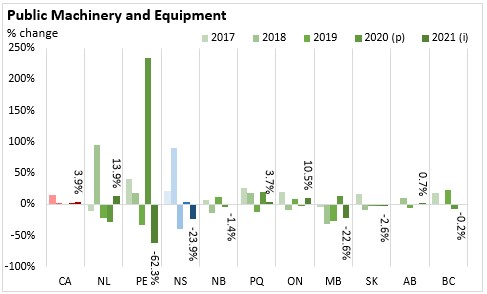
In 2019, investment is software increase 12.3% across Canada, with the largest percentage increases in British Columbia (+40.9%), Quebec (+33.7%) and Saskatchewan (+32.4%). In Nova Scotia, investment in software increased 27.7% to $227.9 million.
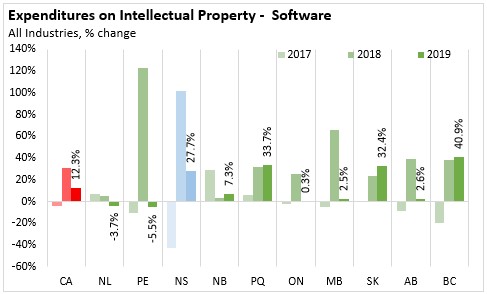
Non-residential capital and repair expenditures, 2021 (intentions)
Non-residential capital and repair expenditures, 2020 (revised intentions)
<--- Return to Archive